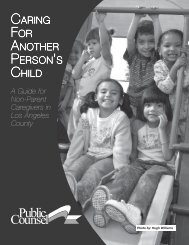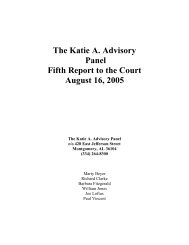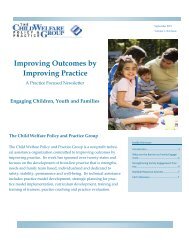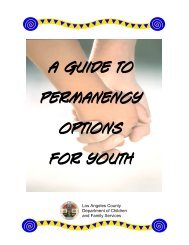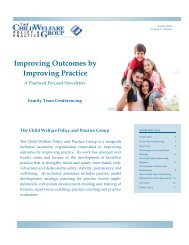Los Angeles County Self-Assessment Report
Los Angeles County Self-Assessment Report
Los Angeles County Self-Assessment Report
Create successful ePaper yourself
Turn your PDF publications into a flip-book with our unique Google optimized e-Paper software.
Key Components of POE:<br />
• Differential (Community) response: provision of a community-based network of<br />
formal and informal support services for children and families with an inconclusive<br />
child abuse and neglect referral to divert families from entering the child protective<br />
system.<br />
• Alternative Response: provision of a community-based network of formal and<br />
informal support and services for children and families with multiple inconclusive<br />
child abuse and neglect referrals to divert families from entering the child protective<br />
system.<br />
• Voluntary Services: provision of voluntary family maintenance/reunification and<br />
family preservation services to families that have been assess to be at moderate to<br />
high risk where a child protective case is opened.<br />
• Intensive Services Workers: conduct child safety conferences shortly after detention<br />
to review for possible return of children and/to connect children and families to<br />
services immediately following detention.<br />
• Team-Decision-making/Child Safety Conferences: provides a forum for the family,<br />
relatives, friends, social workers and community service providers to share<br />
information, observations, concerns and identify family strengths and resources to<br />
assist in the development of an appropriate service plan for the family.<br />
In December of 2006, The Children and Families Research Consortium submitted a<br />
report to DCFS that provided findings of a qualitative study on Point of Engagement as<br />
it was implemented in the Compton and Wateridge offices. In summary, they found that<br />
Team Decision Making was viewed as a positive and productive practice that is<br />
consistent with the principles of POE. Many benefits of TDM were described by various<br />
stakeholders, including the ability to better engage families in the decision making<br />
process and being able to include family supports and community representatives in the<br />
development of a safety plan. Stakeholders noted that the “process helps build<br />
cooperation from families” and “TDMs in which supervisors are present have a built-in<br />
screening process that helps to more appropriately recommend a program to a family.”<br />
The Emergency Response staff reported that their roles have significantly changed as a<br />
result of POE, stating that they have much greater contact with community-based<br />
agencies through referral, assessment and follow-up and have greater responsibility<br />
with immediately securing services that help mitigate safety and risk factors in order to<br />
reduce reliance on out-of-home care. The expectation is to work more collaboratively<br />
with agencies, families, and internal DCFS staff.<br />
The qualitative study also noted some challenges with the implementation of TDM,<br />
including difficulty with training enough skilled facilitators who are available when<br />
needed, and the regular, systematic use of TDMs. Finding the space to hold TDMs was<br />
also an issue and affected the timeliness in which TDMs were completed. The primary<br />
18



